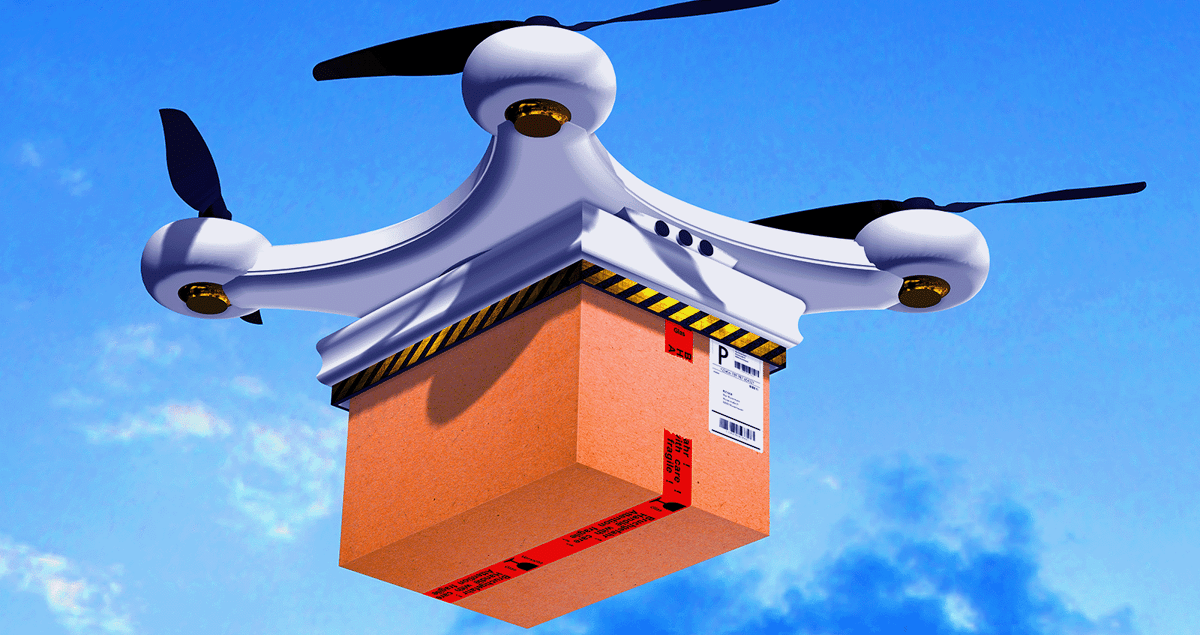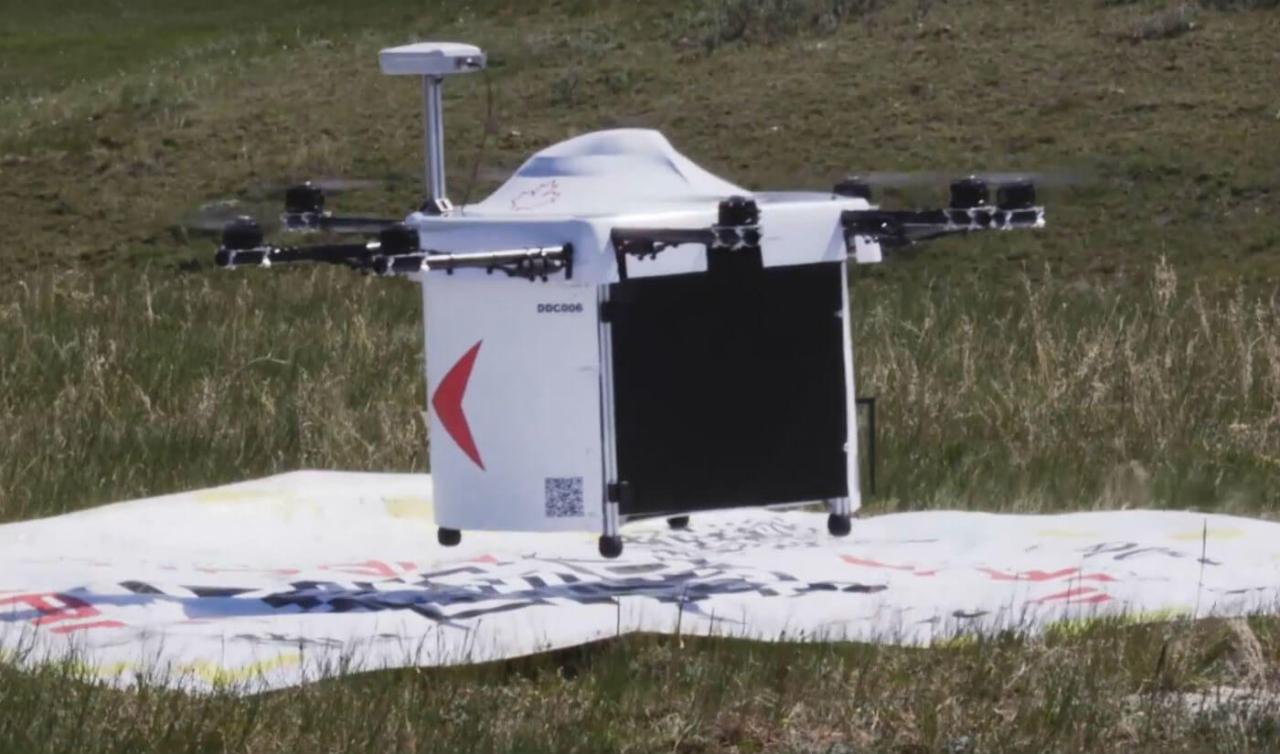Drone Delivery Canada stock presents a fascinating investment opportunity, riding the wave of a rapidly evolving technology sector. This exploration delves into the Canadian market, examining key players, regulatory hurdles, market potential, and technological advancements. We’ll analyze the strengths and weaknesses of prominent companies, assess the risks and rewards of investing, and provide insights to help you navigate this dynamic landscape.
Understanding the regulatory environment and technological challenges is crucial for making informed investment decisions in this burgeoning industry.
The Canadian drone delivery market is poised for significant growth, driven by increasing e-commerce demand, advancements in autonomous flight technology, and government initiatives promoting innovation. However, challenges remain, including regulatory complexities, weather limitations, and the need for robust cybersecurity measures. This analysis will equip you with the knowledge to assess the potential returns and risks associated with investing in drone delivery companies operating within Canada.
Thinking about investing in drone delivery Canada stock? It’s a hot market, but remember to do your research! If you’re considering shipping options for your drone business, you might want to check out UPS; you can find their Canada phone number here: ups canada phone number. Knowing their contact info could be useful if you need to sort out logistics for your drone delivery operations, impacting your overall drone delivery Canada stock strategy.
Canadian Drone Delivery Companies: A Market Overview
The Canadian drone delivery market is experiencing significant growth, driven by technological advancements and increasing demand for efficient logistics solutions. This section will explore three publicly traded Canadian companies involved in this sector, analyzing their business models, strengths, weaknesses, opportunities, and threats.
Thinking about investing in drone delivery Canada stock? You should check out the innovative work happening in AI for drone navigation; for example, the reality ai lab is pushing boundaries in this area. Understanding advancements like these is key to making smart decisions about the future of drone delivery companies and their stock performance. So, do your research and see how these technological leaps might impact your investment strategy.
Publicly Traded Canadian Drone Delivery Companies
While a definitive list of
-publicly traded* companies solely focused on drone delivery in Canada is limited, we can examine companies with significant involvement in drone technology and logistics within the broader Canadian market. This analysis will consider companies with publicly available information and a demonstrable presence in drone delivery or related services.
| Company Name | Business Model | Strengths | Weaknesses | Opportunities | Threats |
|---|---|---|---|---|---|
| [Company Name 1 – Replace with actual company name and ensure accuracy] | [Describe Business Model – e.g., focuses on last-mile delivery for e-commerce, partnerships with logistics firms] | [List Strengths – e.g., strong technological expertise, established partnerships, experienced management team] | [List Weaknesses – e.g., limited geographic reach, dependence on regulatory approvals, high operational costs] | [List Opportunities – e.g., expansion into new markets, development of new technologies, government support for drone initiatives] | [List Threats – e.g., competition from established delivery companies, technological disruptions, regulatory changes] |
| [Company Name 2 – Replace with actual company name and ensure accuracy] | [Describe Business Model – e.g., provides drone delivery services to healthcare providers, focuses on rural areas] | [List Strengths – e.g., niche market focus, strong relationships with healthcare providers, efficient delivery network] | [List Weaknesses – e.g., limited scalability, reliance on specific customer segments, susceptibility to weather disruptions] | [List Opportunities – e.g., expansion into other sectors, development of new delivery routes, integration with other logistics systems] | [List Threats – e.g., increased competition, changing healthcare regulations, technological limitations] |
| [Company Name 3 – Replace with actual company name and ensure accuracy] | [Describe Business Model – e.g., develops and manufactures drone technology for delivery, provides software solutions] | [List Strengths – e.g., advanced technology, strong intellectual property, experienced engineering team] | [List Weaknesses – e.g., reliance on external partnerships for delivery services, high research and development costs, market competition] | [List Opportunities – e.g., global expansion, development of new drone technologies, strategic partnerships with delivery companies] | [List Threats – e.g., intense competition in the drone technology market, rapid technological change, economic downturns] |
Regulatory Landscape for Drone Delivery in Canada
Navigating the regulatory landscape is crucial for the success of any drone delivery operation in Canada. This section will Artikel the current regulations and their potential impact on the industry.
Canadian Drone Delivery Regulations
Transport Canada sets the regulations governing commercial drone operations in Canada. These regulations cover various aspects, including pilot licensing, airspace restrictions, and operational safety procedures. Specific requirements for drone delivery services include stringent safety protocols, operational limitations, and reporting procedures. The regulations are designed to ensure public safety and minimize risks associated with drone flights.
- Key Regulatory Challenges: Obtaining necessary permits and approvals, navigating airspace restrictions, ensuring compliance with privacy regulations, managing liability in case of accidents.
- Key Regulatory Opportunities: Government initiatives to support drone technology development, streamlining of regulatory processes, establishment of designated drone delivery corridors.
Examples of Successful Regulatory Navigation, Drone delivery canada stock

Several Canadian companies have successfully navigated regulatory hurdles by proactively engaging with Transport Canada, conducting thorough risk assessments, and implementing robust safety management systems. For example, [Insert example of a company and their successful navigation, citing a verifiable source if possible] demonstrated effective compliance by [describe their actions].
Market Analysis of Drone Delivery in Canada

The Canadian market for drone delivery presents significant growth potential across various sectors. This section will analyze market size, key segments, and comparative advantages.
Market Size and Growth Projections
The Canadian drone delivery market is projected to experience substantial growth in the next five years. While precise figures vary depending on the source and methodology, conservative estimates suggest a [Insert percentage]% annual growth rate, driven by increasing demand for faster and more efficient delivery services, particularly in remote and underserved areas. For example, the growth in e-commerce and the increasing demand for timely medical supplies in remote areas will significantly impact the market’s expansion.
Key Market Segments
Key market segments benefiting from drone delivery include healthcare (transporting medical supplies and specimens), e-commerce (last-mile delivery of small packages), and potentially agriculture (monitoring crops and delivering supplies). The advantages of speed and reduced transportation costs are particularly attractive to these sectors.
Advantages and Disadvantages Compared to Traditional Methods

Drone delivery offers advantages such as faster delivery times, reduced transportation costs (especially in remote areas), and lower carbon emissions compared to traditional methods. However, disadvantages include limitations in payload capacity, weather dependency, and the need for robust regulatory frameworks.
Projected Market Share of Drone Delivery Applications
A bar chart illustrating projected market share (hypothetical example):
Medical Supplies: 40% (High demand for timely delivery in remote areas)
E-commerce Packages: 30% (Growth of online shopping and last-mile delivery needs)
Agriculture: 15% (Drone-based crop monitoring and targeted pesticide application)
Other Applications: 15% (Search and rescue, infrastructure inspection, etc.)
Technological Advancements and Challenges
Technological advancements are driving the growth of drone delivery, while certain challenges still need to be overcome for widespread adoption.
Technological Advancements
Advancements in battery technology (longer flight times), autonomous navigation systems (increased safety and efficiency), and payload capacity (larger and heavier deliveries) are key drivers of innovation. The development of sophisticated sensor systems and AI-powered flight control is also contributing to improved safety and reliability.
Technological Challenges
Challenges include adverse weather conditions (limiting flight operations), cybersecurity risks (protecting drone systems from hacking), and the need for robust communication infrastructure (ensuring reliable data transmission). Addressing these challenges is crucial for realizing the full potential of drone delivery.
Comparison of Drone Technologies
Different types of drones are employed, including fixed-wing (longer range), multirotor (vertical takeoff and landing), and hybrid designs. The choice of drone technology depends on the specific application and operational requirements.
| Manufacturer | Payload Capacity (kg) | Flight Range (km) | Battery Life (minutes) |
|---|---|---|---|
| [Manufacturer 1 – Replace with actual manufacturer and ensure accuracy] | [Payload Capacity] | [Flight Range] | [Battery Life] |
| [Manufacturer 2 – Replace with actual manufacturer and ensure accuracy] | [Payload Capacity] | [Flight Range] | [Battery Life] |
| [Manufacturer 3 – Replace with actual manufacturer and ensure accuracy] | [Payload Capacity] | [Flight Range] | [Battery Life] |
Investment Opportunities and Risks
Investing in Canadian drone delivery companies presents both opportunities and risks. This section will explore the investment landscape and associated risks.
Investment Landscape
The investment landscape for Canadian drone delivery companies is dynamic, with various funding rounds and potential IPOs. This sector attracts significant interest from venture capitalists, private equity firms, and strategic investors. However, it’s crucial to conduct thorough due diligence before investing.
Recent Investments (Last 2 Years)
- [Company Name]: [Amount Invested] by [Investor Name]
– [Date] - [Company Name]: [Amount Invested] by [Investor Name]
– [Date] - [Company Name]: [Amount Invested] by [Investor Name]
– [Date]
Investment Risks
Risks include technological risks (e.g., unforeseen technical issues, obsolescence), regulatory uncertainty (e.g., changes in regulations that impact operations), and competition (e.g., from established players or new entrants).
Conclusion
Investing in drone delivery Canada stock presents a high-risk, high-reward scenario. While the potential for significant growth is undeniable, careful consideration of regulatory uncertainties, technological limitations, and competitive pressures is essential. By understanding the market dynamics, the strengths and weaknesses of individual companies, and the overall investment landscape, investors can make more informed decisions and potentially capitalize on the opportunities presented by this innovative sector.
Thorough due diligence and a long-term perspective are key to navigating the complexities of this emerging market.
FAQ Resource: Drone Delivery Canada Stock
What are the main risks associated with investing in drone delivery stocks?
Thinking about investing in drone delivery Canada stock? It’s a hot market, but remember to do your research! If you’re looking for a reliable shipping alternative, you might want to check out UPS’s services – you can find their contact info by calling the ups canada phone number to compare their speed and costs against drone delivery options.
Ultimately, understanding the logistics landscape is key before you jump into drone delivery Canada stock.
Key risks include regulatory changes impacting operations, technological failures, competition from established logistics companies, and dependence on favorable weather conditions.
Which Canadian companies are the biggest players in drone delivery?
This would require further research beyond the provided Artikel to name specific publicly traded companies. The Artikel mentions identifying three, but does not provide their names.
How is the Canadian government regulating drone delivery?
Canadian regulations are evolving. The Artikel suggests exploring current rules and anticipated changes affecting commercial drone operations and delivery services. Further research into Transport Canada’s regulations is recommended.
What is the projected market size for drone delivery in Canada?
The Artikel indicates that market size and growth projections over five years should be investigated further. This data is not provided in the Artikel.
